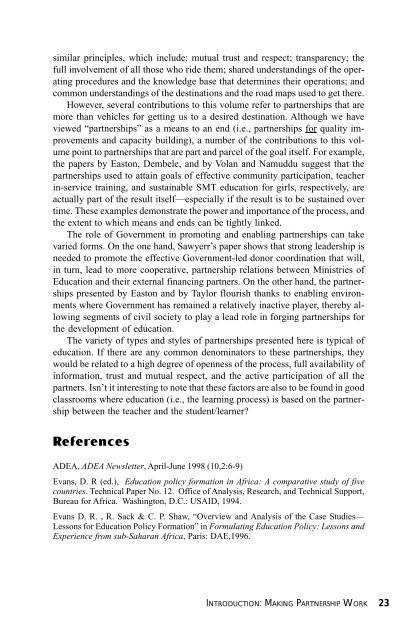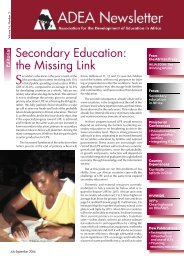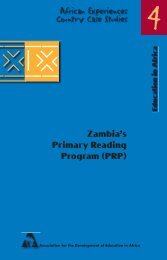Partnerships for Capacity Building and Quality ... - ADEA
Partnerships for Capacity Building and Quality ... - ADEA
Partnerships for Capacity Building and Quality ... - ADEA
You also want an ePaper? Increase the reach of your titles
YUMPU automatically turns print PDFs into web optimized ePapers that Google loves.
similar principles, which include: mutual trust <strong>and</strong> respect; transparency; thefull involvement of all those who ride them; shared underst<strong>and</strong>ings of the operatingprocedures <strong>and</strong> the knowledge base that determines their operations; <strong>and</strong>common underst<strong>and</strong>ings of the destinations <strong>and</strong> the road maps used to get there.However, several contributions to this volume refer to partnerships that aremore than vehicles <strong>for</strong> getting us to a desired destination. Although we haveviewed “partnerships” as a means to an end (i.e., partnerships <strong>for</strong> quality improvements<strong>and</strong> capacity building), a number of the contributions to this volumepoint to partnerships that are part <strong>and</strong> parcel of the goal itself. For example,the papers by Easton, Dembele, <strong>and</strong> by Volan <strong>and</strong> Namuddu suggest that thepartnerships used to attain goals of effective community participation, teacherin-service training, <strong>and</strong> sustainable SMT education <strong>for</strong> girls, respectively, areactually part of the result itself—especially if the result is to be sustained overtime. These examples demonstrate the power <strong>and</strong> importance of the process, <strong>and</strong>the extent to which means <strong>and</strong> ends can be tightly linked.The role of Government in promoting <strong>and</strong> enabling partnerships can takevaried <strong>for</strong>ms. On the one h<strong>and</strong>, Sawyerr’s paper shows that strong leadership isneeded to promote the effective Government-led donor coordination that will,in turn, lead to more cooperative, partnership relations between Ministries ofEducation <strong>and</strong> their external financing partners. On the other h<strong>and</strong>, the partnershipspresented by Easton <strong>and</strong> by Taylor flourish thanks to enabling environmentswhere Government has remained a relatively inactive player, thereby allowingsegments of civil society to play a lead role in <strong>for</strong>ging partnerships <strong>for</strong>the development of education.The variety of types <strong>and</strong> styles of partnerships presented here is typical ofeducation. If there are any common denominators to these partnerships, theywould be related to a high degree of openness of the process, full availability ofin<strong>for</strong>mation, trust <strong>and</strong> mutual respect, <strong>and</strong> the active participation of all thepartners. Isn’t it interesting to note that these factors are also to be found in goodclassrooms where education (i.e., the learning process) is based on the partnershipbetween the teacher <strong>and</strong> the student/learner?References<strong>ADEA</strong>, <strong>ADEA</strong> Newsletter, April-June 1998 (10,2:6-9)Evans, D. R (ed.), Education policy <strong>for</strong>mation in Africa: A comparative study of fivecountries. Technical Paper No. 12. Office of Analysis, Research, <strong>and</strong> Technical Support,Bureau <strong>for</strong> Africa. Washington, D.C.: USAID, 1994.Evans D. R. , R. Sack & C. P. Shaw, “Overview <strong>and</strong> Analysis of the Case Studies—Lessons <strong>for</strong> Education Policy Formation” in Formulating Education Policy: Lessons <strong>and</strong>Experience from sub-Saharan Africa, Paris: DAE,1996.INTRODUCTION: MAKING PARTNERSHIP WORK 23

















